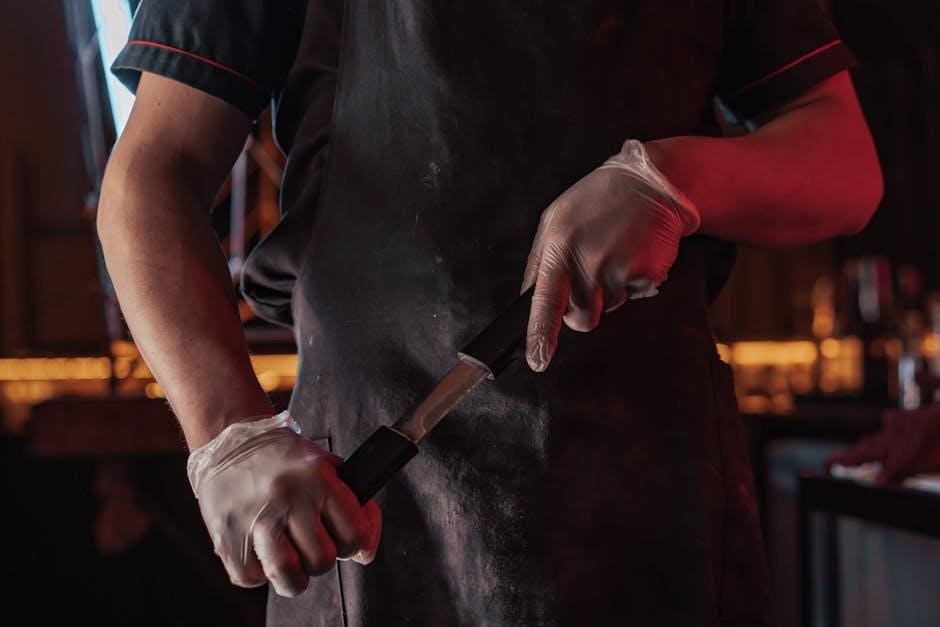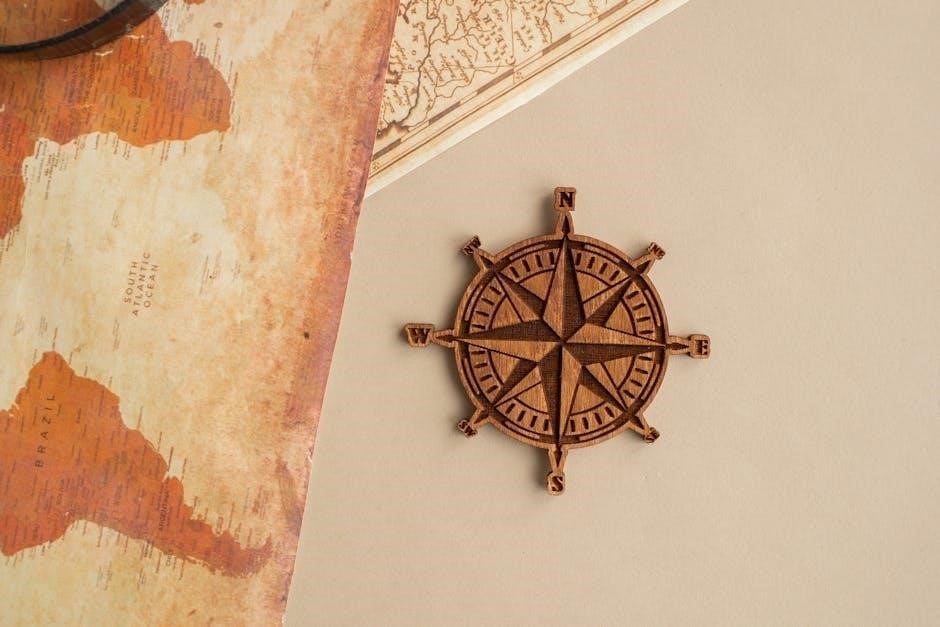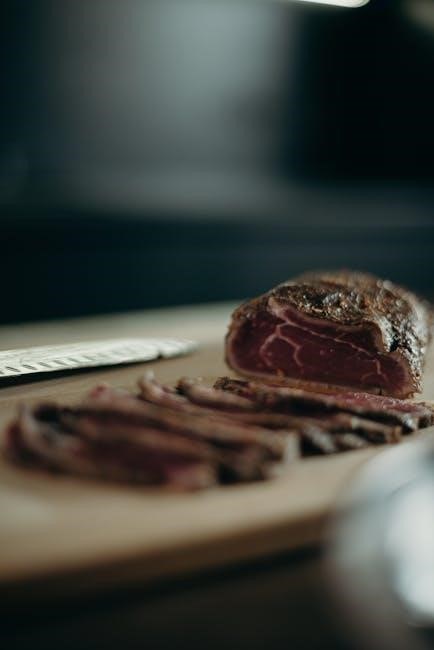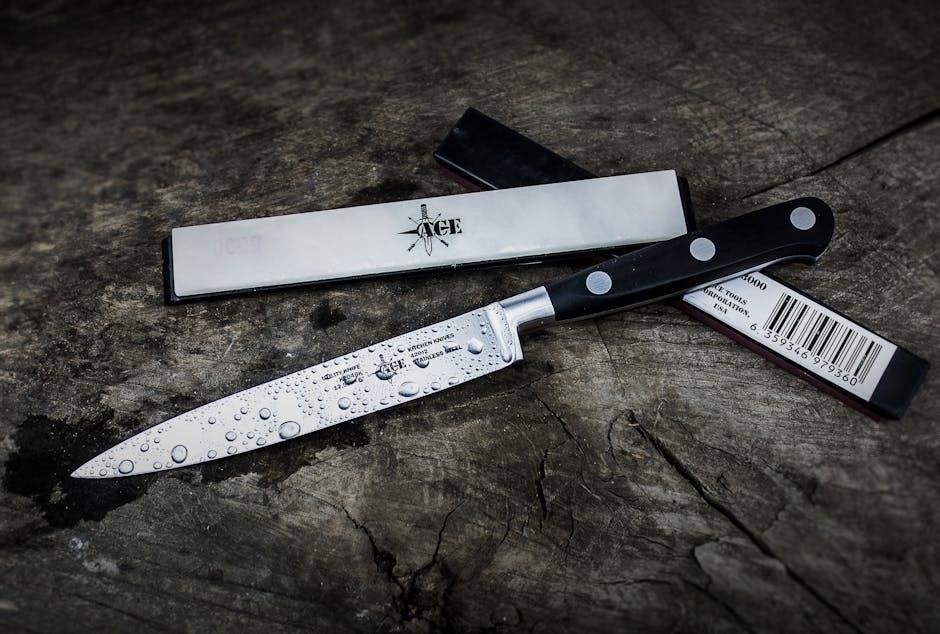Understanding the proper sharpening angle is crucial for maintaining knife performance. Different knives require specific angles, ensuring optimal sharpness and durability. This guide explores the essentials of knife angle sharpening.
1.1 Importance of Sharpening Angles
Sharpening angles are critical for achieving a razor-sharp edge and ensuring knife longevity. The correct angle enhances cutting efficiency, edge retention, and safety. Incorrect angles can lead to a dull edge or blade damage. Different knives, like chef knives or pocket knives, require specific angles based on their use and blade thickness. Understanding the ideal angle for your knife ensures optimal performance and extends its lifespan. Proper sharpening angles balance sharpness and durability, making them essential for both everyday use and specialized tasks. This guide helps you master the angles for any knife, ensuring precision and effectiveness in every cut.
1.2 Brief Overview of Knife Sharpening
Knife sharpening involves refining the blade’s edge to achieve optimal sharpness and performance. It requires precision and the right tools to create a precise angle, ensuring the knife cuts efficiently. Sharpening can be done manually with stones or guided systems, each offering unique benefits. Regular maintenance is essential to prevent dullness and extend the knife’s lifespan. Whether for culinary use or outdoor activities, a well-sharpened knife enhances safety and effectiveness. This guide provides a comprehensive approach to understanding and mastering the sharpening process, ensuring your knives remain in peak condition for any task.

Factors Determining the Best Sharpening Angle
The best sharpening angle depends on blade type, usage, thickness, steel, and tools. These factors ensure optimal sharpness and durability for specific tasks.
2.1 Blade Type and Usage
The blade type and its intended use significantly influence the optimal sharpening angle. For instance, kitchen knives, such as chef knives, often require angles between 15° and 20° per side, resulting in a total edge angle of 30° to 40°. This range balances sharpness and durability for cutting and chopping tasks. Thinner blades, like fillet knives, may benefit from sharper angles for precision, while thicker, heavier-duty knives might use slightly wider angles for added strength. The specific function of the knife, whether for slicing, chopping, or filleting, dictates the ideal angle to maximize performance and edge retention.
2.2 Blade Thickness and Steel Type
Blade thickness and steel type are critical factors in determining the best sharpening angle. Thicker blades typically require wider angles for added durability, while thinner blades benefit from narrower angles for sharper edges. Harder steel types can withstand narrower angles, maintaining sharpness longer, whereas softer steels may need slightly wider angles to prevent chipping. The combination of blade thickness and steel type directly impacts edge retention and cutting performance, making it essential to tailor the sharpening angle accordingly for optimal results.
2.3 Sharpening Tools and Techniques
Sharpening tools and techniques play a vital role in achieving the correct angle. Sharpening stones, electric sharpeners, and honing steels are popular tools that help maintain precise angles. Manual sharpening requires skill and consistency, while guided systems offer precision for beginners. The choice of tool often depends on the knife’s intended use and the user’s expertise. Proper techniques, such as consistent strokes and controlled pressure, ensure the angle is maintained throughout the sharpening process. Using the right tool and technique combination is essential for achieving a razor-sharp edge and extending the knife’s longevity.

Common Sharpening Angles for Different Knives
Knives typically use angles like 14°, 17°, 20°, or 25°, depending on their type and use. These angles ensure optimal sharpness and durability for various cutting tasks.
3.1 Standard Angles for Kitchen Knives
Kitchen knives typically use sharpening angles of 15° or 20° per side, resulting in total angles of 30° or 40°. These angles balance sharpness and durability, making them ideal for everyday use. A 20° angle is common for chef’s knives, offering versatility and edge retention, while a 15° angle provides a sharper edge, though it may require more maintenance. The total angle is double the sharpening angle, ensuring optimal performance for cutting and slicing tasks. These standards are widely recommended for their effectiveness in maintaining knife functionality and longevity in the kitchen.
3.2 Specialized Angles for Specific Knives
Specialized knives often require unique sharpening angles tailored to their function. Fillet knives, for instance, benefit from a narrower 10°-15° angle for precision and flexibility. Cleavers, designed for heavy-duty chopping, use a robust 25°-30° angle for durability. Serrated knives may require a slightly different approach, focusing on maintaining the existing angle rather than creating a new one. Straight-edge knives typically use a standard 20° angle, while Japanese knives, like sushi knives, often use a narrower 15° angle for precise cuts. Understanding these specialized angles ensures optimal performance for each knife type, enhancing their specific cutting capabilities and longevity.
3.3 Variable Angles for Versatility
Variable sharpening angles offer flexibility for different knife types and tasks. Many sharpening guides feature adjustable settings, such as 14°, 17°, 20°, and 25°, allowing users to customize the angle for their specific needs. This versatility is particularly useful for multi-purpose knives, where a slightly steeper angle can enhance durability, while a shallower angle improves sharpness. By adjusting the angle, users can tailor the edge to suit the knife’s intended use, ensuring optimal performance. This adaptability makes variable angles a valuable feature for both everyday carry knives and specialized tools, providing a balance between sharpness and edge retention. Precision is key for versatility.

How to Determine the Correct Sharpening Angle
Determining the correct sharpening angle involves considering blade type, usage, and thickness. Tools like sharpening guides with preset angles (14°, 17°, 20°, 25°) help achieve precise results.
4.1 Using a Sharpening Guide
A sharpening guide is an essential tool for maintaining precise angles. These guides feature preset angles (14°, 17°, 20°, 25°) to suit various knives. By placing the blade in the guide, users ensure consistency. The clever design accommodates different blade sizes, ensuring the exact angle is maintained. This tool is particularly useful for beginners, as it eliminates guesswork. Advanced users also benefit from its precision. The guide ensures that the sharpening process is uniform, leading to a razor-sharp edge. Regular use of a sharpening guide enhances knife performance and extends its lifespan by preventing uneven wear.
4.2 Measuring Existing Angles
Measuring existing angles ensures consistency in sharpening. Use a sharpening guide or angle measurement tool to determine the current bevel angle. For precision, align the blade with the guide’s edge. Digital gauges are ideal for accuracy. Alternatively, visually inspect the bevel to estimate the angle. This step is crucial for maintaining the knife’s original geometry. By measuring first, you avoid over-sharpening or altering the blade’s intended design. Consistent measurements ensure the knife retains its performance and longevity. Always double-check the angle before sharpening to achieve the best results.

Choosing the Right Tools for Angle Sharpening
Choosing the right tools is essential for precise angle sharpening. Sharpening stones, electric sharpeners, and honing steels each offer unique benefits for achieving and maintaining optimal angles.
5.1 Sharpening Stones and Their Angle Settings
Sharpening stones are versatile tools for achieving precise angles. They come with built-in angle settings, such as 14°, 17°, 20°, and 25°, catering to different knife types. These settings ensure consistency, allowing users to maintain the exact angle needed for their blade. Whether sharpening a chef’s knife or a pocket knife, the stone’s design adapts to blade size. The angle settings are crucial for optimal sharpness and durability, as they align with the knife’s intended use and steel type. While electric sharpeners offer convenience, stones provide unmatched control for enthusiasts seeking precision.
5.2 Electric Sharpeners and Angle Precision
Electric sharpeners offer unmatched convenience and precision for maintaining the perfect sharpening angle. Many models feature built-in angle guides, ensuring consistency across strokes. These devices often include preset angles, such as 14°, 17°, 20°, and 25°, catering to various knife types. The design ensures the blade is sharpened evenly, preventing over-sharpening. Electric sharpeners are ideal for beginners, as they simplify the process, while also appealing to experts seeking efficiency. Their ability to maintain precise angles makes them a valuable tool for achieving razor-sharp edges and extending knife longevity, especially for those who value speed and reliability in their sharpening routine.
5.3 Honing Steels for Maintenance
Honing steels are essential for maintaining knife edges, realigning microteeth without removing metal. They extend sharpness between sharpening sessions and are available in diamond or ceramic types. Regular use prevents dulling and maintains performance. While they don’t sharpen, they’re crucial for knife care. Including them in your routine ensures a consistent edge, enhancing both sharpness and longevity. Proper use of honing steels is a simple yet effective way to keep your knives in optimal condition, making them a must-have tool for any knife owner.
Maintaining the Sharpening Angle
Maintaining the correct sharpening angle ensures consistent sharpness and prevents damage. Techniques like using jigs or guides help preserve the angle, while regular honing sustains edge performance.
6.1 Techniques for Consistency
Achieving consistency in sharpening requires precise techniques. Using a sharpening guide ensures the angle remains steady, while maintaining uniform strokes and pressure prevents uneven edges. Regular practice enhances muscle memory, allowing for repeatable results. Additionally, marking the blade helps track progress, ensuring each stroke aligns with the previous one. By focusing on these methods, users can maintain the desired angle consistently, leading to a sharper, more durable edge. Consistency is key to extending the knife’s lifespan and optimizing its performance in various tasks.
6.2 Using Sharpening Jigs
Sharpening jigs are essential tools for maintaining consistent angles during the sharpening process. These devices clamp the knife at the desired angle, guiding each stroke precisely. They are particularly useful for beginners, as they eliminate guesswork and ensure accuracy. Many jigs are adjustable, accommodating various blade types and sizes. By securing the knife in place, jigs help prevent common mistakes like uneven bevels or incorrect angles. This level of control not only enhances sharpness but also extends the knife’s longevity. For those seeking precision and reliability, sharpening jigs are indispensable, making the process easier and more effective for all skill levels.

Step-by-Step Guide to Sharpening at the Correct Angle
A step-by-step guide to sharpening at the correct angle involves positioning the knife, setting the desired angle, using a guide for accuracy, sharpening with light strokes, and checking progress for optimal results.
7.1 Manual Sharpening Process
Manual sharpening involves placing the knife at the desired angle on a sharpening stone. Hold the knife firmly, with the bevel flat against the stone. Lightly draw the blade across the stone in smooth, consistent strokes, moving from heel to tip. Repeat on the other side, maintaining the same angle. Check progress regularly by inspecting the edge or cutting a test material. Use a sharpening guide if needed for precision. Continue until the edge is razor-sharp, finishing with a honing steel to refine the edge. Consistency in angle and pressure ensures a sharp, durable blade.
7.2 Using Guided Sharpening Systems
Guided sharpening systems simplify the process by ensuring precise angle control. Attach the guide to the knife, aligning it with the desired angle. Place the knife on the sharpening stone, moving it smoothly from heel to tip. The guide eliminates guesswork, maintaining consistent pressure and angle. Repeat on the other side, then check the edge sharpness. For finer edges, reduce pressure and repeat. Finish with a honing steel to polish the blade. Guided systems are ideal for beginners, as they ensure accuracy and prevent common mistakes, resulting in a sharp, evenly honed edge every time.

Common Mistakes to Avoid
Incorrect angle setup and inconsistent strokes are common errors. Using improper tools or applying too much pressure can damage the blade. Always use a sharpening guide for accuracy.
8.1 Incorrect Angle Setup
One of the most frequent mistakes is using the wrong sharpening angle for the knife type. Each knife, depending on its use, requires a specific angle to maintain its edge effectively. Using a single angle for all knives can lead to poor sharpness and reduced durability. For example, a chef’s knife and a pocket knife have different optimal angles. Always refer to the manufacturer’s guidelines or use a sharpening guide to ensure accuracy. Incorrect angles can result in a dull edge or uneven bevels, which compromise the knife’s performance and longevity. Proper setup is key to achieving a razor-sharp edge.
8.2 Inconsistent Strokes and Pressure
Inconsistent strokes and uneven pressure are common mistakes that can ruin the sharpening process. Applying too much pressure can damage the blade, while too little may not sharpen effectively. Similarly, varying stroke patterns can lead to an uneven edge. To avoid this, maintain steady, controlled movements and consistent pressure throughout the sharpening process. Using a sharpening guide or jig can help regulate both stroke consistency and pressure, ensuring a uniform edge. Practice is key to developing a smooth, even technique that yields a sharp, durable blade. Avoid rushing, as patience is essential for achieving professional-level results.

The Importance of Consistency
Consistency in sharpening angle and technique ensures a sharp, durable edge. It prevents uneven wear and extends the knife’s lifespan, making maintenance more effective and reliable over time.

9.1 Impact on Edge Sharpness
Consistency in sharpening angle directly affects edge sharpness. A well-maintained angle ensures a razor-sharp edge, while inconsistent angles lead to a dull, uneven blade. Proper technique prevents micro-tears, enhancing cutting performance and reducing wear. Regular maintenance with the correct angle preserves the knife’s sharpness, making it safer and more efficient for tasks. Inconsistent sharpening can result in a blade that struggles to cut effectively, compromising both safety and functionality. By adhering to the optimal angle, users achieve a sharper, more durable edge, ensuring peak performance for various cutting tasks.
9.2 Effect on Knife Longevity
Consistent sharpening angles significantly impact knife longevity. Proper angle maintenance prevents excessive wear, extending the blade’s lifespan. Inconsistent angles can lead to uneven edges, reducing durability and requiring more frequent sharpening. A well-sharpened knife retains its edge longer, resisting dulling and damage. Regular maintenance at the correct angle ensures the blade remains effective over time, avoiding premature wear. Neglecting angle consistency can shorten the knife’s usable life, making it less reliable for cutting tasks. By prioritizing precise sharpening, users can enjoy a longer-lasting, high-performance knife that withstands the demands of frequent use.
How Sharpening Angle Affects Performance
The sharpening angle directly impacts a knife’s sharpness, edge retention, and cutting ability. A precise angle balances durability and sharpness, ensuring optimal performance for specific tasks and knife types.
10.1 Sharpness and Edge Retention
A precise sharpening angle enhances a knife’s sharpness and edge retention. Narrower angles, like 15º, produce razor-sharp edges ideal for slicing, while wider angles, such as 20º, offer durability for heavy use. The angle must balance sharpness and retention, as too narrow may lead to a fragile edge, and too wide can result in a dull knife. Proper techniques and tools ensure the angle maintains the edge’s integrity, directly impacting the knife’s performance and longevity; This balance is critical for optimal cutting ability and extended blade life across various knife types and uses.
10.2 Cutting Ability and Durability
The sharpening angle significantly impacts a knife’s cutting ability and durability. A narrower angle enhances sharpness for precise cuts, ideal for tasks like slicing. Wider angles improve durability, making the knife more resistant to wear during heavy use. The right angle balances these factors, ensuring the knife performs effectively without compromising longevity. For example, a 15º angle excels for delicate cuts, while a 20º angle is better for rugged tasks. Proper angle selection ensures the knife retains its cutting efficiency and withstands the demands of its intended use, making it a reliable tool for both precision and strength. This balance is essential for optimal performance.
Advanced Sharpening Techniques
Exploring advanced sharpening techniques involves custom angles for specific tasks, micro-bevels for enhanced performance, and specialized tools for precision. These methods elevate knife sharpening to an art form.
11.1 Custom Angles for Specific Tasks
Custom sharpening angles are tailored to meet the demands of specific knife uses; For instance, fillet knives benefit from a narrower angle for precision, while axes require a wider angle for strength. By adjusting the bevel angle, users can optimize edge retention and cutting efficiency. This technique ensures the knife performs exceptionally for its intended purpose, whether slicing delicate fish or chopping heavy materials. Using a sharpening guide or specialized tools, enthusiasts can achieve these precise angles, enhancing their knife’s versatility and effectiveness in various tasks.
11.2 Micro-Bevels for Enhanced Performance
Micro-bevels are small, secondary angles added to a knife’s edge for enhanced performance. These subtle angles improve edge retention and reduce drag, making cutting smoother and more efficient. By creating a micro-bevel, users can tailor the knife’s edge to specific tasks, such as slicing or chopping. This technique is particularly useful for high-carbon steel blades, as it strengthens the edge and prevents chipping. Advanced sharpening tools allow precise control over micro-bevel creation, ensuring optimal results. This method is favored by professionals seeking peak performance from their knives, making it a valuable skill for enthusiasts and experts alike.
Mastering knife angle sharpening ensures sharper, more durable edges. Consistency and the right tools are key. Thanks for joining this comprehensive guide—happy sharpening, and remember, practice makes perfect!
12.1 Summary of Key Points
12.2 Final Tips for Effective Sharpening
- Always use a sharpening guide to maintain consistent angles.
- Apply light, even pressure to avoid damaging the blade.
- Sharpen in one direction only for better edge retention.
- Regularly hone your knife to maintain sharpness between sharpening sessions.
- Choose the right sharpening tool based on your knife type and skill level.
- Practice on inexpensive knives to refine your technique.
- Store knives properly to prevent dulling and maintain their edge.
By following these tips, you can achieve professional-level sharpness and extend your knife’s lifespan.

